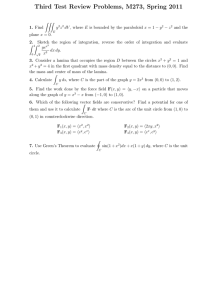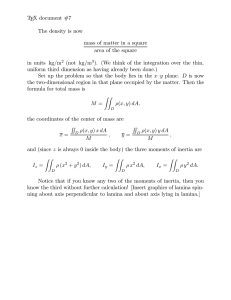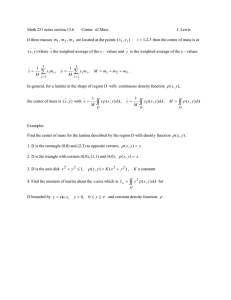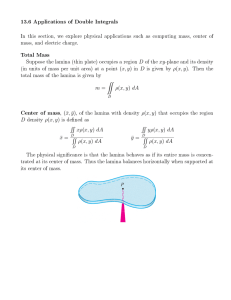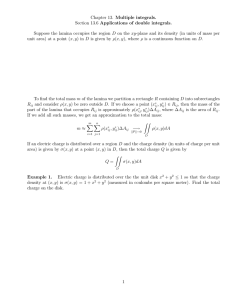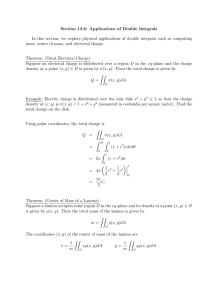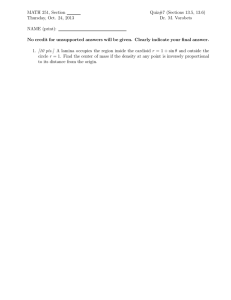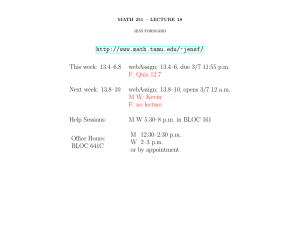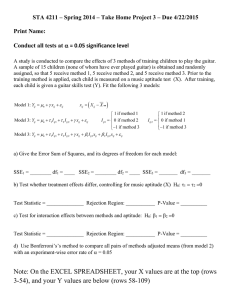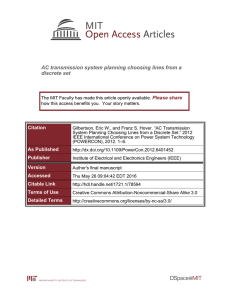Document 11901927
advertisement
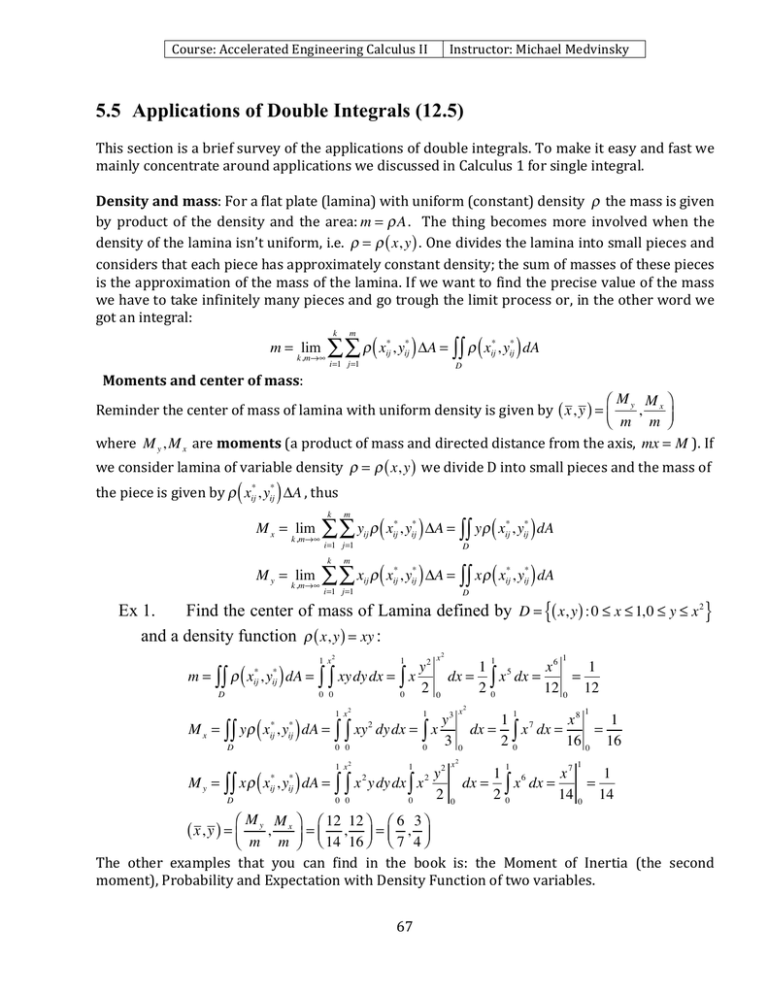
Course: Accelerated Engineering Calculus II Instructor: Michael Medvinsky 5.5 Applications of Double Integrals (12.5)
This section is a brief survey of the applications of double integrals. To make it easy and fast we mainly concentrate around applications we discussed in Calculus 1 for single integral. Density and mass: For a flat plate (lamina) with uniform (constant) density ρ the mass is given by product of the density and the area: m = ρ A . The thing becomes more involved when the density of the lamina isn’t uniform, i.e. ρ = ρ ( x, y ) . One divides the lamina into small pieces and considers that each piece has approximately constant density; the sum of masses of these pieces is the approximation of the mass of the lamina. If we want to find the precise value of the mass we have to take infinitely many pieces and go trough the limit process or, in the other word we got an integral: m = lim
∑ ∑ ρ ( x , y ) ΔA = ∫∫ ρ ( x , y ) dA k
k,m→∞
m
*
ij
*
ij
*
ij
i=1 j=1
*
ij
D
Moments and center of mass: ⎛M M ⎞
Reminder the center of mass of lamina with uniform density is given by ( x, y ) = ⎜ y , x ⎟ ⎝ m m ⎠
where M y , M x are moments (a product of mass and directed distance from the axis, mx = M ). If we consider lamina of variable density ρ = ρ ( x, y ) we divide D into small pieces and the mass of (
)
the piece is given by ρ xij* , yij* ΔA , thus k,m→∞
M y = lim
∑ ∑ y ρ ( x , y ) ΔA = ∫∫ yρ ( x , y ) dA
k
M x = lim
ij
*
ij
*
ij
*
ij
i=1 j=1
*
ij
D
∑ ∑ x ρ ( x , y ) ΔA = ∫∫ x ρ ( x , y ) dA
k
k,m→∞
m
m
ij
*
ij
*
ij
*
ij
i=1 j=1
*
ij
D
Ex 1.
Find the center of mass of Lamina defined by D = {( x, y ) : 0 ≤ x ≤ 1,0 ≤ y ≤ x 2 }
and a density function ρ ( x, y ) = xy :
(
1 x2
)
1
y2
m = ∫∫ ρ xij* , yij* dA = ∫ ∫ xy dy dx = ∫ x
2
D
0 0
0
(
)
1 x2
)
2
x2
0
(
1
M y = ∫∫ x ρ xij* , yij* dA = ∫ ∫ x 2 y dy dx ∫ x 2
D
0 0
x2
1
y3
M x = ∫∫ y ρ xij* , yij* dA = ∫ ∫ xy 2 dy dx = ∫ x
3
D
0 0
0
1 x
0
0
2
2 x
y
2
1
1
1
x6
1
dx = ∫ x 5 dx =
=
20
12 0 12
0
1
1
1
x8
1
dx = ∫ x 7 dx =
=
20
16 0 16
1
dx =
7 1
1 6
x
1
x dx =
=
∫
20
14 0 14
⎛ M y M x ⎞ ⎛ 12 12 ⎞ ⎛ 6 3 ⎞
,
=⎜ , ⎟ =⎜ , ⎟
⎝ m m ⎟⎠ ⎝ 14 16 ⎠ ⎝ 7 4 ⎠
The other examples that you can find in the book is: the Moment of Inertia (the second moment), Probability and Expectation with Density Function of two variables. ( x, y ) = ⎜
67 Course: Accelerated Engineering Calculus II Instructor: Michael Medvinsky 5.6 Surface Area (12.6)
Consider the parametric surface r ( u,v ) = x ( u,v ) , y ( u,v ) , f ( u,v ) .
Recall: A tangent plane to parametric surface r ( u,v ) at point v0 is given by n ⋅ ( v − v0 ) = 0 where
n = ru × rv . To approximate the area of 3D surface we divide the domain into small rectangles Rij and sum the areas of corresponding patches of the surface. To approximate the area of the patch one uses tangent plan at the lower corner of Rij , i.e. at the point ui* ,v*j . (
)
Consider the following vectors:
Δuru ui* ,v*j = r ui* ,v*j + Δuru ui* ,v*j − r ui* ,v*j
Δvrv ui* ,v*j = r ui* ,v*j + Δvrv ui* ,v*j − r ui* ,v*j
(
(
) {(
) {(
)
)
(
)
)} (
)} (
(
(
)
)
The area of the parallelogram defined by these two vectors approximates the area of the patch, thus m k
m k
* *
* *
Δu
r
u
,v
×
Δv
r
u
,v
=
∑∑ u i j
∑ ∑ ru ui*,v*j × rv ui*,v*j ΔuΔv v
i
j
i=1 j=1
(
)
(
i=1 j=1
) (
)
Finally we take this trough the limit process and get
A = ∫∫ ru ( u,v ) × rv ( u,v ) dA D
If the surface is represented by z=f(x,y) then one defines r ( x, y ) = x, y, f ( x, y ) and get
rx ( x, y ) × ry ( x, y ) = 1,0, fx × 0,1, fy = − fx ,− fy ,1 = 1+ fx2 + fy2 Thus A = ∫∫ 1+ fx2 + fy2 dA . (Note the similarity to the arc-­‐length formula.) D
Ex 2.
Find area of the surface given by r ( x, y ) = x, xy,
y
x
on rectangle −1 ≤ x, y ≤ 1 .
rx × ry = 2xy, y 2 ,0 × x 2 ,2xy,0 = 0,0, 3x 2 y 2 = 3x 2 y 2
1 1
1
1
x3
A = ∫ ∫ 3x y dy dx = ∫ x y −1 dx = ∫ 2x dx = 2
3
−1 −1
−1
−1
2 2
2
31
68 1
=
2
−1
4 3
